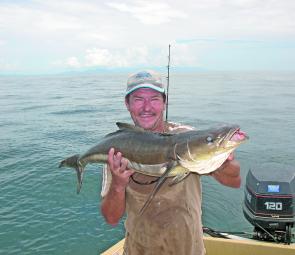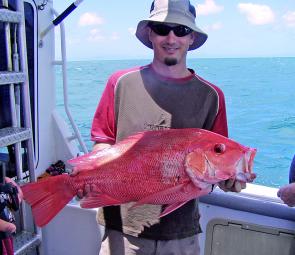May traditionally experiences a drop in air temperatures so there will be a significant cold snap at some stage during the night. This is when old sweaters come out of mothballs and it is a time of re-adjustment for us all.
There is also re-adjusting for our fish species. Our prized barra will move into a sleepy mode and will tend to feed in warmer shallow bays and stretches of water. Using smaller lures will prove more successful but the barra will still be hard to target.
With a mediocre finish to the wet season, barra moved some time ago from the headlands back into the rivers and creeks. Gradual sloping banks with some form of structure in the shallows is ideal. If you can find such an area which is also a pressure point receiving plenty of current, the better.
Other areas worthwhile targeting are freshly fallen mangrove trees in the water, which attract bait and ultimately a source of food for bigger fish. Best days will include plenty of sunshine coinciding with leading into the full and new moons.
Mangrove jack and fingermark will ease off their super aggressive attitude displayed during the warmer months but will feed actively when hungry. Fish to take up the slack will be quality sized queenfish and trevally, which will move deep into our systems on the bigger tides. Working channel entrances with live baits or casting poppers should attract attention.
On the bigger tides, grunter will be on the move across estuary flats. At certain locations near river mouths, permit or snub-nosed dart will be partial to pumped yabbies or a fresh peeled prawn. Bream also appreciate a drop in temperature and they will be quite active amongst rock walls and harbour pylons.
Offshore fishing conditions also change as the current switches direction, coming from the south bringing cooler water. And one would expect the trademark southeasterly winds to become more consistent.
If winds remain relatively calm the reef fishing can really fire as anchoring becomes easier to fall back onto a specific target.
The big mover this month should be the small mouth nannygai, which have been patchy over the warmer months. Looking back at recent years, the days leading into the new and full moons during May have seen these fish explode in huge numbers. Fishing on isolated bommies in 25-35m of water showing plenty of life on the sounder, should see them at home and if they come on the bite bag limits are easily achieved in short time.
The largemouth specimens will continue to be part of the day's catch in deeper water and have been a really consistent catch over the warmer months. Coral trout will return to more consistent form shifting to shallower waters and become easy pickings as long as their is some current.
There has already been positives signs that we might be in for a big Spanish mackerel season. Tell tale locations have already seen massive schools roaming the waters with fish taken between 5-15kg. In similar areas there have been a high concentration of longtail and juvenile yellowfin tuna, which is a positive sign.
Other species which have risen their profile in recent years during May have been cobia and reef mangrove jack. Always have a floating fusilier or pilchard out the back when anchored and you could tussle with a number of species.
If the weather can hold, May is a month where reef species and pelagics turn on the light and provide some awesome angling. Inshore your big 1m queenfish and trevally species will be a feature.
Reads: 1407
Shane Down caught this cobia amongst a flurry of Spanish mackerel action.

The largemouth nannygai have been biting extremely well during the warmer months and should continue as the seasons change.




